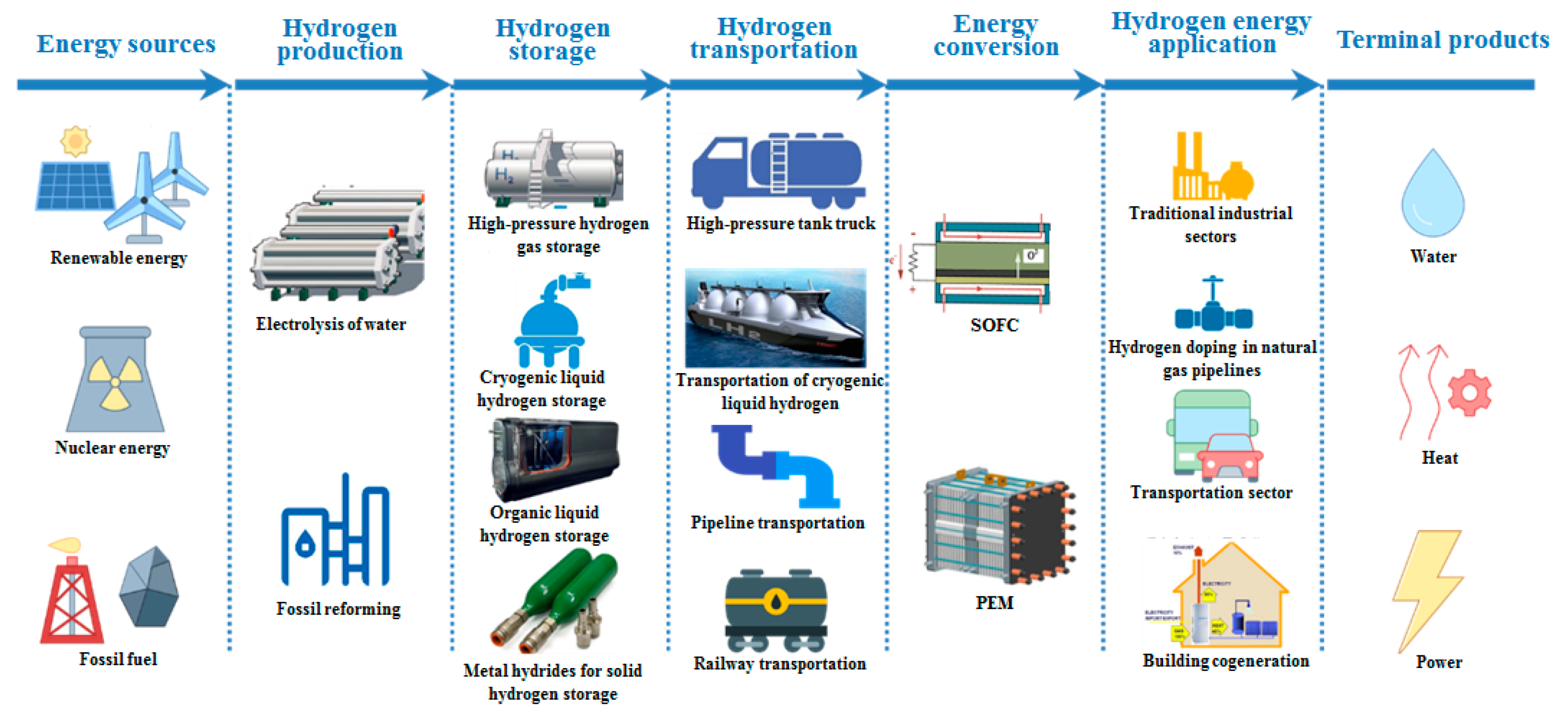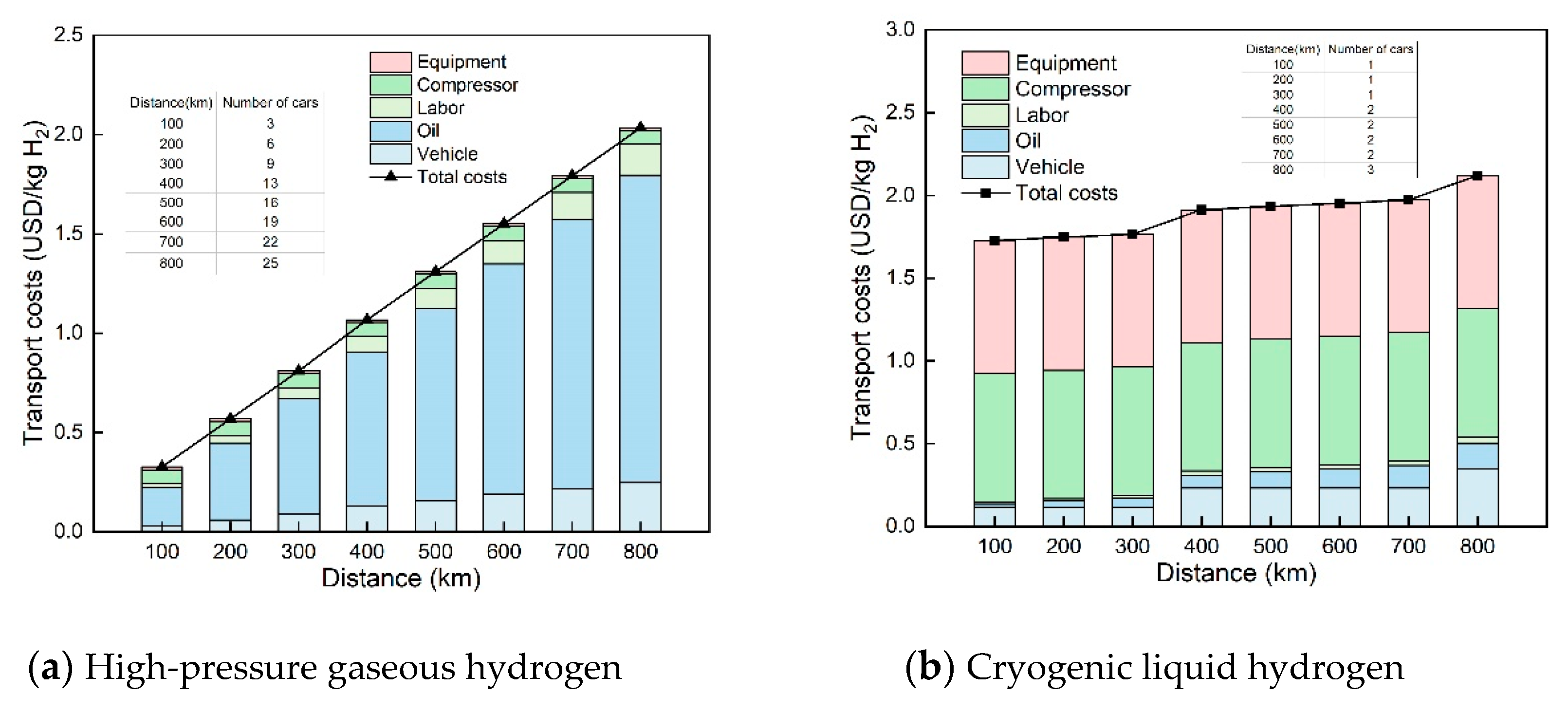1. Introduction
As a fuel for new energy, hydrogen has the characteristics of high calorific value, light weight, and high endurance. Hydrogen can generate electricity through chemical reactions, where water is the only product. Using fossil energy (coal, natural gas, etc.) to produce hydrogen causes carbon dioxide pollution. However, using renewable energy curtailment (hydropower, wind power, photovoltaic power) to produce hydrogen via electrolysis of water provides new ideas for the nonpolluting production of hydrogen. Thus, hydrogen is also known as the most ideal clean energy in the application process [
1], and it is one of the main directions of sustainable energy development. Japan, China, the United States, and many countries in Europe are actively promoting the application of hydrogen fuel cell vehicles (FCVs) and the development of the hydrogen energy industry chain [
2].
China is one of the world’s largest economic powers with development potential. The energy upgrade of China represents an important determinant of its economic transformation [
3]. With the signing of “the Paris Agreement”, the Chinese government promised to adopt more powerful policies and measures to achieve “a carbon peak in 2030 and carbon neutrality in 2060”. To achieve this goal, the energy system must undergo profound changes, from a system based mainly on fossil fuels to a low-carbon energy system that is highly efficient, renewable, and sustainable [
4]. Hydrogen energy is a good material carrier for renewable electricity. Through using hydrogen, renewable energy production and clean energy consumption can be effectively connected to make up for the low temporal and spatial matching between renewable resources and energy consumption. Hydrogen can be used in transportation, industrial production, daily energy, and so on, providing new ideas for clean and low-carbon energy utilization [
5]. Moreover, hydrogen provides new research directions for companies and researchers in the industry chain. As an efficient and multipurpose energy medium with electricity and fossil fuels, hydrogen has outstanding advantages in terms of its social and economic application in the transportation field [
6].
In 2019, the global sales of FCVs were 7500 units, an increase of 35.7% over 2018, to which China made the greatest contribution [
7]. It is estimated that, by 2030, the production scale and sales of hydrogen FCVs will reach 500,000 in China, the number of possessions will reach one million, and the corresponding hydrogen demand will reach 5.8145 million tons. China has become the main potential market for hydrogen fuel. The Hydrogen Council predicts that, by 2050, the hydrogen energy industry will reduce carbon dioxide emissions by about 6 Gt globally, of which the transportation field accounts for approximately 3.2 Gt, as shown in
Figure 1. In the future, hydrogen vehicles will account for 20–25% of the total number of vehicles in the world and will represent 18% of the global energy demand [
8]. Hydrogen fuel is the energy source of hydrogen FCVs. According to Chinese national standard GB/T37244-2018, hydrogen as a fuel has characteristics of high purity, as shown in
Table 1 [
9]. Compared with fossil energy, hydrogen fuel is more expensive [
10]. Therefore, it is important to control the use cost of hydrogen fuel so as to gain an edge in the Chinese market. The use cost of hydrogen can be further divided into hydrogen production cost and trading cost.
Currently, research on hydrogen cost mainly focuses on factors influencing the hydrogen production cost and on methods of reducing it. For example, Boretti described Australia’s export of hydrogen produced from coal, natural gas, wind, and solar power to Japan and South Korea [
11]. Dispenza et al. estimated the cost of hydrogen production from water electrolysis at Capo d’Orlando, a solar-powered hydrogen fueling station in Sicily, from the aspects of design, construction, characteristics, and operation [
12]. Through the comparison of three cases, it was found that power trading is the main factor affecting the cost of hydrogen without considering the availability of renewable energy or fuel demand. Saenz-Aguirre et al. explored ways to reduce the cost of hydrogen production in combination with wind energy and found that producing hydrogen with power generated by wind turbines can reduce the carbon emissions in hydrogen energy production and promote the development of the electric vehicle industry [
13]. Voldsund et al. found that carbon capture technology is required in hydrogen production by fossil fuels to save energy and reduce emissions, and this, in turn, increases the cost of hydrogen production [
14]. Sorgulu et al. used the “Hydrogen Economic Evaluation Program (HEEP)” software developed by the International Atomic Energy Agency (IAEA) to evaluate the hydrogen production plan and cost of two nuclear power plants in Turkey. It was found that the cost of hydrogen (H
2) ranges from 3.18 USD/kg to 6.17 USD/kg after calculating and evaluating the cost of investment, fuel, electricity, decommissioning, and consumables for production, storage, and transportation [
15]. Ishaq et al. studied the cost and carbon emission analysis and optimization of hydrogen production and power generation by solar-driven steam-autothermal hybrid methane reforming in the presence of a carbon tax [
16]. However, as the main potential market for hydrogen fuel, China is rarely analyzed for the cost-economic production of hydrogen. In this paper, a hydrogen energy cost model is established to research the effect of hydrogen production cost, including raw material cost, fixed production cost, and hydrogen purification cost, as well as carbon trading cost and transportation cost, on the cost of hydrogen in China. Considering its future development, the benefits of reducing the cost of hydrogen are discussed to propose a method of hydrogen supply which has the characteristics of large scale and low cost.
6. Conclusions
By 2030, China’s hydrogen fuel demand will exceed 5 million tons, and procuring low-cost hydrogen will be the key to opening up the application market in China’s fuel cell transportation field. Hydrogen as a fuel has high purity and is, thus, costly. Raw materials and technologies determine that hydrogen production from fossil fuels (coal and natural gas) are the main methods for large-scale hydrogen production. However, as environmental pressures increase in the future, hydrogen production from fossil fuels will endure stricter purification requirements and higher carbon trading prices. The cost of hydrogen from fossil fuels will increase. Hydrogen production from water electrolysis can be used for small-scale onsite pure hydrogen production. The cost is not affected by purification but mainly limited by the price of electricity. The promotion and application of renewable electricity provide a new way to reduce the price of electricity for hydrogen production from water electrolysis. A model was established to analyze the cost of hydrogen energy, hydrogen transportation, and carbon trading in this paper. Accordingly, it is recommended to use renewable energy curtailment as a source of electricity and multi-stack system electrolyzers as large-scale electrolysis equipment in the future, combined with liquid hydrogen transportation or onsite hydrogen production as the most economical choice. With improvements in the power trading mechanism and carbon trading mechanism in the future, participating in these two trading mechanisms can be combined to reduce the cost of hydrogen. On the one hand, by participating in electricity market-oriented transactions and cross-regional transactions, the cost of electricity as a raw material for hydrogen production can be reduced. On the other hand, by participating in carbon trading, electrolyzed water hydrogen production enterprises can sell surplus carbon emission rights to subsidize the cost of hydrogen production from electrolyzed water. The hydrogen market is developing rapidly; thus, the supply of hydrogen will gradually increase. Considerations must be taken of the storage cost, as well as the impact of different hydrogen energy applications, trading mechanisms, centralized production, and distributed production on the cost of hydrogen. These problems are to be further discussed.












